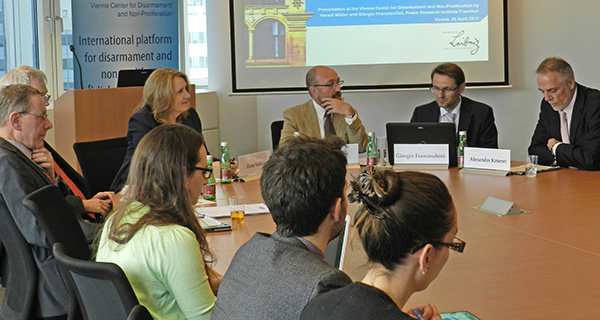

On 23 April 2015, Dr. Harald Müller and Mr. Giorgio Franceschini presented the findings of a Peace Research Institute Frankfurt (PRIF) study "A Nuclear Weapon-Free Zone in Europe: Concept – Problems – Chances." The study arose from the interests of several states to explore the feasibility of such a zone. The report also builds on the Treaty on the Non-Proliferation of Nuclear Weapons (NPT) 2010 Action Plan, which called for the establishment of new nuclear-weapon-free zones (NWFZs). The PRIF study examines potential benefits, shortcomings, consequences, and stumbling blocks. The authors found that such a zone is not only possible, but has a number of merits including the establishment of an innovative approach to counter the "trend of stagnation on nuclear disarmament" and recent challenges to security in Europe.
Dr. Müller began the discussion by answering two questions: why a NWFZ and why in Europe? He explained the appeal of a regional zone is that it provides security assurances and the opportunity to go beyond NPT obligations, as well as constitutes a "safety net" should the NPT fail. In response to the latter question, he provided several reasons:
Mr. Franceschini addressed the elements of a possible European NWFZ, including essential obligations (e.g. forgoing any acquisition, possession, use, or transfer of nuclear weapons), non-essential obligations from which states could opt-out (e.g. no participation in nuclear planning), and those that are non-essential but useful (e.g. nuclear and radiological safety and security measures). He also examined lessons from other NWFZs that might be applicable to a zone in Europe, such as the way in which Pelindaba Treaty negotiators addressed the existence of a nuclear-armed state in their region, South Africa. Rather than let the presence of a nuclear weapon state prevent the formation of an African NWFZ, the negotiators solved this problem by allowing new members to join after the zone’s establishment, once their disarmament was verified. This could be particularly useful for a NWFZ in Europe, which would necessarily have its own "patchwork problem" with, at least initially, "holes" in the zone. The African precedent solution would allow France, the United Kingdom, and Russia to join once a similar arrangement was fulfilled.
Dr. Müller and Mr. Franceschini discussed possible solutions to a number of potential challenges that negotiators might face creating a NWFZ in Europe. Politically, interested states will have to prepare themselves for significant opposition to the creation of such a zone. Dr. Müller suggested that it would be best to conduct "closed-shop" talks among like-minded states before they present the idea to a broader group, and to ensure they have sufficient domestic support for the zone in order to withstand what he predicted would be inevitable backlash, which could threaten the survival of the initial negotiations. Given that the Ukraine crisis has reinvigorated Cold War-era hostility, opposition to a NWFZ in Europe would likely come from both NATO as well as Russia. Identifying the appropriate venue will also be an important step during the pre-negotiation phase.
Due to these challenges, Dr. Müller advised a realistic and minimalist approach to what he predicted would likely be a lengthy process. He also concluded that, while the endeavor is both legal and legitimate, it will likely face strong opposition and require interested states to invest much political capital. The willingness to use such capital, Dr. Müller emphasized, will be key to the successful creation of a NWFZ in Europe.
